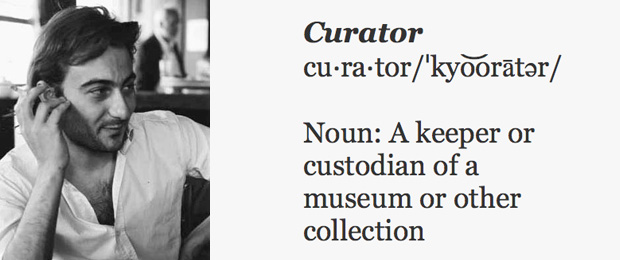
A brief history of the word ‘curator’
Once solely employed to describe the exhibition maker, now it's used for anyone from a celebrity music festival programmer to a Williamsburg hipster with an iTunes account. British Art Show curator Tom Morton talks us through the origins of the most overused word of modern times
A very short history of the word 'curator' might run as follows. In Ancient Rome, curatores were senior civil servants in charge of various departments of public works, overseeing the Empire's aqueducts, bathhouses and sewers. Fast forward to the medieval period, and we encounter the curatus, a priest devoted to the care (or 'cura') of souls.
By the end of the 20th century, 'curator' came to describe a broad category of exhibition makers, from museum employees who spend years working on modest, scrupulously researched displays of Sumerian pottery, to freelancers who approach large scale Biennales of contemporary art as an opportunity to clear their auteurial throat.
Here in the third millennium, the word curator has undergone a further shift in usage. Appropriated by the marketing departments of businesses keen to imbue their products with an air of hard-won distinction and borrowed avant-garde cool, it is now used to describe anybody from the celebrity programmer of a pop festival to a fashion stylist who puts together a 'capsule collection' from a department store's fall/winter stock. A curator, here, is essentially a paid selector of stuff for sale, whether it be concert tickets or cuff links. (Notably, commercial art galleries tend to fight shy of describing their exhibitions staff as 'curators', leaving the title to professionals in the not-for-profit sector who do not, um, profit from the works that they choose to display).
Of course, there is a possibility that the marketeers who employ the word 'curator' have no more interest in evoking the world of the museum than they do of evoking Roman middle management or the medieval church.
Perhaps they are merely responding to the wider 'curatorial turn' in patterns of consumption outlined in New York-based literary magazine n+1’s collection of essays What Was The Hipster? which argues that the current generation of fashionable young things are 'prosumers' who prefer to select cultural artifacts rather than produce them, brandishing them 'like capital'. The 'curator' of a pop up shop or a boutique festival renders even this stunted form of creativity redundant - as the comedian Stewart Lee wrote in a recent article in the Financial Times on his appointment as the 'curator' of a weekend of comedy at a major London arts venue "I am a curator. What a dead word. It sounds like somebody stirring turds in a toilet bowl with a stick." So quite what Lee would make of the mission statement of the astonishingly named Seattle PR firm Curator is fun to contemplate. Without a trace of historical awareness, the company's website avers that "The most effective brands - knowing the influence of today's empowered consumer - will create products, services or experiences that can stand-up to the conversation of the marketplace." It’s a long way from the public museum, let alone aqueduct administration or the care of the eternal soul.
Tom Morton, Curator of the British Art Show